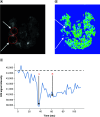Undesired impact of iron supplement on MRI assessment of post-treatment glioblastoma
- PMID: 36408899
- PMCID: PMC9830595
- DOI: 10.2217/cns-2021-0018
Undesired impact of iron supplement on MRI assessment of post-treatment glioblastoma
Abstract
Glioblastoma (GBM) is the most common malignant adult brain and has a poor prognosis. Routine post-treatment MRI evaluations are required to assess treatment response and disease progression. We present a case of an 83-year-old female who underwent MRI assessment of post-treatment GBM after intravenous iron replacement therapy, ferumoxytol. The brain MRI revealed unintended alteration of MRI signal characteristics from the iron containing agent which confounded diagnostic interpretation and subsequently, the treatment planning. Ferumoxytol injection prior to contrast enhanced MRI must be screened in post-treatment GBM patients to accurately evaluate tumor activity.
Keywords: GBM; adverse events; brain tumor; ferumoxytol; imaging.
Figures



Similar articles
-
Combined iron oxide nanoparticle ferumoxytol and gadolinium contrast enhanced MRI define glioblastoma pseudoprogression.Neuro Oncol. 2019 Mar 18;21(4):517-526. doi: 10.1093/neuonc/noy160. Neuro Oncol. 2019. PMID: 30277536 Free PMC article.
-
Distinguishing Extravascular from Intravascular Ferumoxytol Pools within the Brain: Proof of Concept in Patients with Treated Glioblastoma.AJNR Am J Neuroradiol. 2020 Jul;41(7):1193-1200. doi: 10.3174/ajnr.A6600. Epub 2020 Jun 11. AJNR Am J Neuroradiol. 2020. PMID: 32527840 Free PMC article.
-
Tumor protease-activated theranostic nanoparticles for MRI-guided glioblastoma therapy.Theranostics. 2023 Mar 13;13(6):1745-1758. doi: 10.7150/thno.79342. eCollection 2023. Theranostics. 2023. PMID: 37064879 Free PMC article.
-
Recent development of contrast agents for magnetic resonance and multimodal imaging of glioblastoma.J Nanobiotechnology. 2022 Jun 16;20(1):284. doi: 10.1186/s12951-022-01479-6. J Nanobiotechnology. 2022. PMID: 35710493 Free PMC article. Review.
-
Advanced magnetic resonance imaging to support clinical drug development for malignant glioma.Drug Discov Today. 2021 Feb;26(2):429-441. doi: 10.1016/j.drudis.2020.11.023. Epub 2020 Nov 26. Drug Discov Today. 2021. PMID: 33249294
Cited by
-
Association between the Anatomical Location of Glioblastoma and Its Evaluation with Clinical Considerations: A Systematic Review and Meta-Analysis.J Clin Med. 2024 Jun 13;13(12):3460. doi: 10.3390/jcm13123460. J Clin Med. 2024. PMID: 38929990 Free PMC article. Review.
-
Deferiprone and Iron-Maltol: Forty Years since Their Discovery and Insights into Their Drug Design, Development, Clinical Use and Future Prospects.Int J Mol Sci. 2023 Mar 4;24(5):4970. doi: 10.3390/ijms24054970. Int J Mol Sci. 2023. PMID: 36902402 Free PMC article. Review.
References
-
- Clarke JL, Chang S. Pseudoprogression and pseudoresponse: challenges in brain tumor imaging. Curr. Neurol. Neurosci. Rep. 9(3), 241–246 (2009). - PubMed
-
- Cha J, Kim ST, Kim HJ et al. Differentiation of tumor progression from pseudoprogression in patients with posttreatment glioblastoma using multiparametric histogram analysis. Am. J. Neuroradiol. 35(7), 1309–1317 (2014). - PMC - PubMed
-
•• Discusses the usefulness of multiparametric histogram analysis of post-treatment glioblastoma in predicting true tumor progression.
-
- Suh CH, Kim HS, Jung SC, Choi CG, Kim SJ. Multiparametric MRI as a potential surrogate endpoint for decision-making in early treatment response following concurrent chemoradiotherapy in patients with newly diagnosed glioblastoma: a systematic review and meta-analysis. Eur. Radiol. 28(6), 2628–2638 (2018). - PubMed
Publication types
MeSH terms
Substances
LinkOut - more resources
Full Text Sources
Medical
